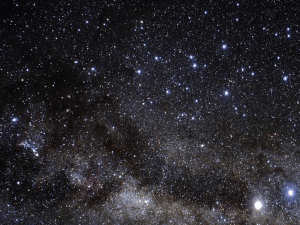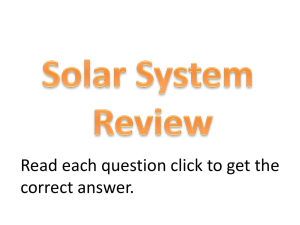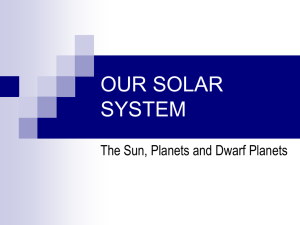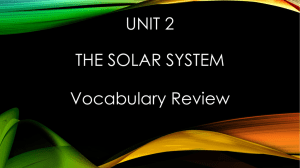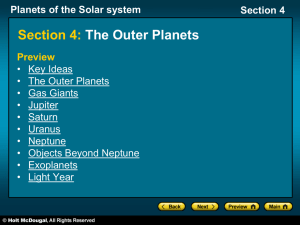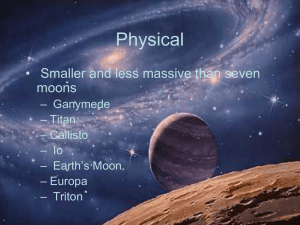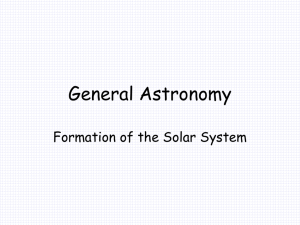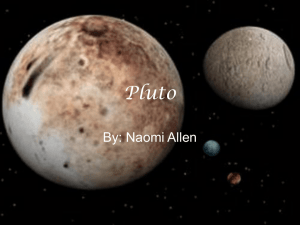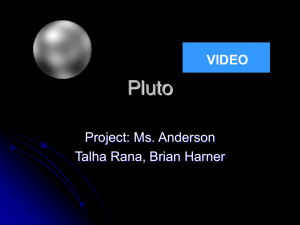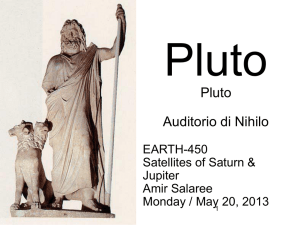Section 26.3 - CPO Science
advertisement
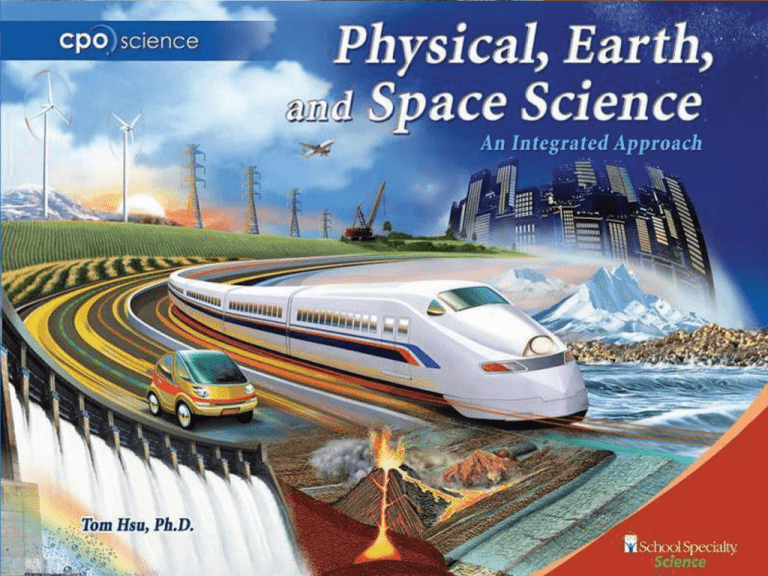
UNIT NINE: Matter and Motion in the Universe Chapter 26 The Solar System Chapter 27 Stars Chapter 28 Exploring the Universe Chapter Twenty-Six: The Solar System 26.1 Motion and the Solar System 26.2 Motion and Astronomical Cycles 26.3 Objects in the Solar System Section 26.3 Learning Goals Explore theories about how the Moon was formed. Compare and contrast properties of planets. Identify features of objects— other than the Sun, the Moon, and planets, in the solar system. 26.3 Objects in the solar system A planet in the solar system is a celestial body that: 1. is in orbit around the Sun; 2. is nearly round in shape; and 3. has cleared its orbit of other objects. 26.3 The planets The planets are commonly classified in two groups. The terrestrial planets include Mercury, Venus, Earth, and Mars. The gas giants include Jupiter, Saturn, Uranus, and Neptune. 26.3 Moons A moon is a natural satellite that orbits a planet or other body, such as a dwarf planet. The planet the moon orbits is called the primary. 26.3 Earth and moon If you have ever observed the Moon, you may have noticed that the same side of it faces Earth at all times. This does not mean that the Moon does not rotate. Over millions of years, Earth’s gravity has locked the Moon’s The time it takes the Moon to rotation to its orbit complete a rotation is the same time around Earth. it takes it to revolve around Earth. 26.3 How the moon was formed What evidence did Apollo moon rocks supply? Before the Apollo landings that began in 1969, there were three main theories. 1. The Moon split off Earth. 2. The Moon formed somewhere else. 3. The Moon and Earth were formed at the same time. Apollo discoveries gave rise to the giant impact theory that is widely accepted today. 26.3 Mercury Mercury, the closest planet to the sun, is the second smallest (after Pluto) in both size and mass. 26.3 Venus Venus appears as the brightest planet in the evening sky and is the third brightest observable object (after the sun and moon). 26.3 Earth Earth is a small, rocky planet with an atmosphere that is made of mostly nitrogen (78 percent N2) and oxygen (21 percent O2). 26.3 Mars The fourth planet out from the sun, Mars appears as a reddish point of light in the night sky. 26.3 Jupiter The fifth planet out from the sun, Jupiter is by far the largest. Jupiter’s mass is greater than the combined mass of all of the other planets. With 63 known moons, Jupiter is like a mini solar system. 26.3 Saturn Saturn, at almost 10 times the size of Earth, is the second largest planet. The most striking feature of Saturn is its system of rings and like Jupiter, has many natural satellites. 26.3 Uranus The seventh planet from the sun, Uranus can barely be seen without a good telescope and was not discovered until 1781. 26.3 Neptune Neptune, the eighth planet from the sun, is the outermost of the gas planets. It was discovered in 1846 and its discovery almost doubled the diameter of the known solar system because of its great distance from the sun. Comparing properties of the planets 26.3 Triton, Pluto and the Kuiper belt Triton is Neptune’s largest moon. Triton and Pluto are similar objects in both composition and size. Some astronomers believe Pluto may actually be an “escaped” moon of Neptune. 26.3 Pluto Pluto is a dwarf planet. Most of the time Pluto is the farthest from the sun. Discovered in 1930, Pluto was named for the Roman god of the underworld. 26.3 Pluto and the Kuiper Belt Pluto is grouped along with Sedna, Xena, and similar distant bodies in the Kuiper Belt Objects (or KBOs). It contains at least three dwarf planets: Pluto, Haumea, and Makemake. 26.3 Asteroids and comets An asteroid is an object that orbits the sun but is too small to be considered a planet. The largest asteroid, named Ceres, is 933 kilometers (580 miles) across. 26.3 Asteroids and comets We believe comets are made mostly of ice and dust. Comets revolve around the Sun in highly elliptical orbits. 26.3 Asteroids and comets The inner core of the comet is the nucleus. As a comet gets closer to the Sun, it forms a tail. 26.3 Meteors and meteorites Occasionally, chunks of rock or dust break off from a comet or asteroid and form a meteor. As Earth orbits the sun, it passes through this debris, creating a meteor shower as the small bits of dust burn up in the atmosphere. 26.3 Meteors and meteorites If a meteor is large enough to survive the passage through Earth’s atmosphere and strike the ground, it becomes a meteorite. Optional* Investigation 26C Solar System Key Question: How big is the solar system? What happened to Pluto? The 2006 meeting, held in Prague, Czech Republic, distinguished astronomers from all over the world came together to exchange ideas at a conference held by the International Astronomical Union (IAU).



